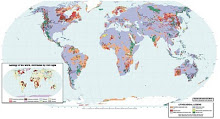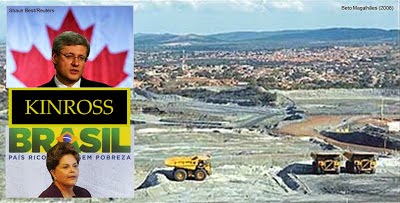Göttingen, August 25, 2009
Germans ask UN for help to avoid a catastrophe in Paracatu, Brazil
By Sergio U. Dani
The Society for Threatened peoples (GfbV) – an international Human Rights organization seated in Göttingen, Germany – wrote today to the World Health Organization requesting the United Nations to interact and avoid a socio-environmental catastrophe in the city of Paracatu, Brazil.
The letter was GfbV answer reaction to Canadian transnational Kinross Gold Corporation permit to install a new tailings dam at the Machadinho Valley, in Paracatu – a valley meant to be the drinking water supply reservoir for the city 90,000 inhabitants.
The foreseen one million tons of arsenic to flood the reservoir is enough to kill ten times over the 7 billion planet population. The mining company own data – undisclosed in the report presented at the session that issued the permit – show that the population of Paracatu is already exposed to a daily level of arsenic which extrapolates by factor 10 the WHO provisional maximum tolerable daily intake of inorganic arsenic. Arsenic is released from exposed gold mine rocks located in the city outskirts.
Paracatu open cut mine inauguration dates back to 1987 and the effects are now emerging as public health investment data have grown 30%. In 2008 Kinross, against all forewarnings from the scientific community on arsenic and other poisonous substances contamination risk, initiated the mine expansion. Siemens AG, a German company, provided a large-scale mill drive system to the mine operator.
The last step for Kinross mining expansion in Paracatu is the construction of the new tailings dam on top of Paracatu’s most valuable drinking water reservoir. The grieving forecast implies thousands – perhaps millions – will die from cancer and other related diseases caused by air, soil and water contamination by arsenic.
Chronic arsenic poisoning promotes vascular, infectious, lung, kidney, liver and endocrine diseases including cancer which will victimize mostly children and young adults. With Kinross’ expansion project, Paracatu mine is likely to become one of the world’s largest source of anthropogenic arsenic. Some recent studies suggest that volatilizated arsenic is going to be released into the atmosphere, causing global concerns.
About Kinross
Canadian Kinross Gold Corporation is seated in Toronto, Canada, listed in the Toronto and New York Stock Exchanges (NYSE:KGC; TSX:K). This company through “facilitation payments” to government representatives does not conceal what it means “to facilitate (to smooth down) its business”. An independent report has implied Tye Burt – a former Deutsche Bank employee and present Kinross’ CEO – into financial fraudulent business. A UN report and a book has implicated Kinross into the looting of the Democratic Republic of Congo’s natural resources.
About Siemens AG
Siemens AG, a worldwide known German company, has supplied parts of the biggest Kinross’ SAG mill in operation in Latin America without questioning a material support to Kinross genocide in Paracatu. When asked about the issue, Siemens’ CEO Jens Wegmann stated that Siemens’ mill drive system in Paracatu is “geared toward energy efficiency and entails further environmental benefits such as maximum savings on the resources employed”. “– It is a basic rule for any major operation in the world that the responsibility for compliance with the approvals and permits granted lies with the operator”, concluded Wegmann.
About GfbV
The Society for Threatened peoples, GfbV – Gesellschaft für bedrohte Völker is an international organization put together to provide Human Rights protection to ethnic- and religious minorities. It is an NGO with advisory status at the UN Economic and Social Council (ECOSOC) and at the European Parliament as well. GfbV headquarters are in Göttingen, Germany.
More detailed information accessible at: http://alertaparacatu.blogspot.com
Friday, October 9, 2009
Subscribe to:
Post Comments (Atom)




No comments:
Post a Comment